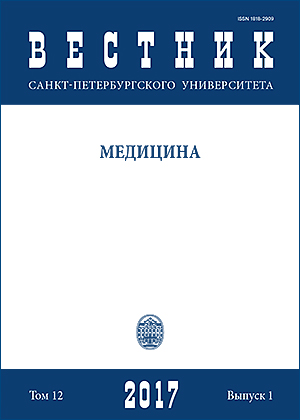ЦЕРЕБРОКАРДИАЛЬНЫЙ СИНДРОМ И ЕГО ОСОБЕННОСТИ У ПАЦИЕНТОВ С ОСТРЫМИ НАРУШЕНИЯМИ МОЗГОВОГО КРОВООБРАЩЕНИЯ
DOI:
https://doi.org/10.21638/11701/spbu11.2017.103Аннотация
Рассматривается цереброкардиальный синдром как комплекс кардиальных нарушений,возникающих на фоне поражения центральной нервной системы и развивающихся чаще всего в результате острого нарушения мозгового кровообращения. Особую роль в его развитии играет поражение вегетативной нервной системы с возникновением местной и системной катехоламиновой цитотоксичности, нейровоспаления и свободнорадикального повреждения.Клинически это приводит к появлению аритмий и других ЭКГ-феноменов, систолической и диастолической дисфункциям, повышению риска внезапной смерти, что требует выявления пациентов с подобными факторами риска, разработки рекомендаций по их диагностике и лечению. Библиогр. 70 назв.
Ключевые слова:
цереброкардиальный синдром, инсульт, аритмия, внезапная смерть
Скачивания
Библиографические ссылки
D. Study protocol:prediction of stroke associated infections by markers of autonomic control // BMC Neurology. 2014. Vol. 14,N 9. P. 230–256.
electrocardiographic monitoring in cryptogenic stroke and transient ischemic attack population: a study protocol for prospective matched cohort study // BMC Cardiovascular Disorders. 2015. Vol. 15. P. 139–160.
echocardiography in a canine model of acute traumatic brain injury // Am. J. Cardiovasc. Dis. 2015. Vol. 5,
N 1. P. 72–76.
Cordonnier C., Csiba L., Davalos A., Diener H. C., Ferro J., Hacke W., Hennerici M., Kaste M., Langhorne P.,Lees K., Leys D., Lodder J., Markus H. S., Mas J. L., Mattle H. P., Muir K., Norrving B., Obach V., Paolucci S.,Ringelstein E. B., Schellinger P. D., Sivenius J., Skvortsova V., Sunnerhagen K. S., Thomassen L., Toni D.,von Kummer R., Wahlgren N. G.,Walker M. F., Wardlaw J.Guidelines for management of ischaemic stroke and transient ischaemic attack. European Stroke Organisation (ESO) Executive Committee. ESO Writing Committee // Cerebrovasc. Dis. 2008. Vol. 25, N 5. Р. 457–507.
P. 486–491.
Dolan R. J.Mental stress and sudden cardiac death: asymmetric midbrain activity as a linking mechanism // Brain. 2005. Vol. 128. P. 75–85.
References
syndrome (tako-tsubo cardiomyopathy): frequency, mechanisms, and prognosis. Chest, 2007, vol. 132,pp. 809–816.
should we know? Cardiology J., 2009, vol. 16, no. 2, pp. 105–112.
nervous system and its possible role in the progression of metabolic syndrome: A new hypothesis. Front Physiol., 2015, vol. 34, pp. 350–367.
S., Kamal M. A. An overview on the correlation of neurological disorders with cardiovascular disease.Saudi J. of Biol. Sci., 2015, vol. 22, pp. 19–23.
increases bone marrow CD4+CD25+FoxP3+ regulatory T cells in mice via signals from sympathetic nervous
system. Brain, behavior, and immunity, 2015, vol. 56, pp. 172–183.
mozgovogo insul’ta [State of simpatico-adrenal system in acute phase of ischemic stroke]. Klinicheskaia meditsina [Clinical medicine], 1966, vol. 9, pp. 42–47. (In Russian)
and repair.Progress in neurobiology,2014, vol. 115, pp. 6–24.
type 2 diabetes: Potential explanations and clinical implications. Curr. Cardiovasc. Risk Rep., 2015, vol. 9,pp. 340–369.
ishemicheskoi bolezni serdtsa [Impact of metabolic system components on natural history of ischemic
heart disease]. Vestnik of Saint Petersburg University. Series 11. Medicine, 2014, issue 4, pp. 18–25.
(In Russian)
sakharnym diabetom 2 tipa [Acute stroke in patients with diabetes mellitus type 2]. Sakharnyi diabet [Diabetes mellitus],2013, no. 1, pp. 63–70. (In Russian)
dizreguliatsii serdtsa pri tserebral’nykh insul’takh [Prognostic value of autonomic dysregulation of heart in stroke]. Biulleten’ sibirskoi meditsiny [Bulletin of Siberian medicine], 2008, no. 17, pp. 15–45.(In Russian)
variabel’nosti ritma serdtsa u patsientov v ostrom periode ishemicheskogo insul’ta [Measurement of interhemispheric asymmetry in stroke patients with heart rate variability]. Asimmetriia [Assymetry], 2015, vol. 9, no. 1, pp. 25–29. (In Russian)
lateral medullary syndrome. BMJ Case Reports, 2013, vol. 36, no. 5, pp. 354–365.
patients with chronic heart failure: results of the ANTHEM-HF trial. J. Card. Fail., 2014, vol. 20, no. 11,
pp. 808–816.
Urban L., Sivák Š. Detection of occult paroxysmal atrial fibrilation by implantable long-term electrocardiographic monitoring in cryptogenic stroke and transient ischemic attack population: a study protocol for prospective matched cohort study.BMC Cardiovascular Disorders,2015, vol. 15, pp. 139–160.
echocardiography in a canine model of acute traumatic brain injury.Am. J. Cardiovasc. Dis.,2015, vol. 5,no. 1, pp. 72–76.
periode mozgovogo insul’ta [Correction of arterial hypertension and neurologic damage in stroke patients
with cardiac-cerebral syndrome].Vestnik aritmologii [Arythmology Herald],2010, no. 60, pp. 35–47.(In Russian)
Lees K., Leys D., Lodder J., Markus H. S., Mas J. L., Mattle H. P., Muir K., Norrving B., Obach V., Paolucci S.,
Ringelstein E. B., Schellinger P. D., Sivenius J., Skvortsova V., Sunnerhagen K. S., Thomassen L., Toni D.,
von Kummer R., Wahlgren N. G.,Walker M. F., Wardlaw J. Guidelines for management of ischaemic stroke
and transient ischaemic attack. European Stroke Organisation (ESO) Executive Committee. ESO Writing
Committee.Cerebrovasc. Dis.,2008, vol. 25, no. 5, pp. 457–507.
sistema reabilitatsii bol’nykh, perenesshikh ishemicheskii insul’t, na etapakh statsionar — reabilitatsionnyi
tsentr — poliklinika [Integrated rehabilitation system of stroke patients in steps of hospital — rehabilitation
center — clinic]. Nevrologicheskii vestnik [Herald of Neurology],2012, no. 44, vol. 4, pp. 3–8. (In Russian)
periode mozgovogo insul’ta [Correction of arterial hypertension and neurologic damage in stroke patients
with cardiac-cerebral syndrome]. Vestnik aritmologii [Arythmology Herald],2010, no. 60, pp. 35–47.
(In Russian)
Nichols D. A., Meyer F. B., Atkinson J. L., Wijdicks E. F. Pulmonary complications of aneurysmal subarachnoid
hemorrhage. Neurosurgery, 2003, vol. 52, pp. 1025–1031.
s fibrilliatsiei predserdii: sostoianie problemy v rutinnoi klinicheskoi praktike [Anticoagulant therapy in patients with atrial fibrillation: state of problem in routine clinical practice].Trudnуi patsient, 2015, no. 7,vol. 13, pp. 36–40. (In Russian)
stroke patients of different age]. Materialy konferentsii s mezhdunarodnym uchastiem “Biopsikhosotsial’nye podkhody v reabilitatsii bol’nykh” [Materials of international conference “Biopsychosocial approach in rehabilitation”]. St. Petersburg, 2015, pp. 83–84. (In Russian)
Analysis of Maccabi Health Services Cardiovascular Database. Isr. Med. Assoc. J., 2015, vol. 17, no. 8,
pp. 486–491.
Dolan R. J. Mental stress and sudden cardiac death: asymmetric midbrain activity as a linking mechanism.
Brain,2005, vol. 128, pp. 75–85.
Загрузки
Опубликован
Как цитировать
Выпуск
Раздел
Лицензия
Статьи журнала «Вестник Санкт-Петербургского университета. Медицина» находятся в открытом доступе и распространяются в соответствии с условиями Лицензионного Договора с Санкт-Петербургским государственным университетом, который бесплатно предоставляет авторам неограниченное распространение и самостоятельное архивирование.




